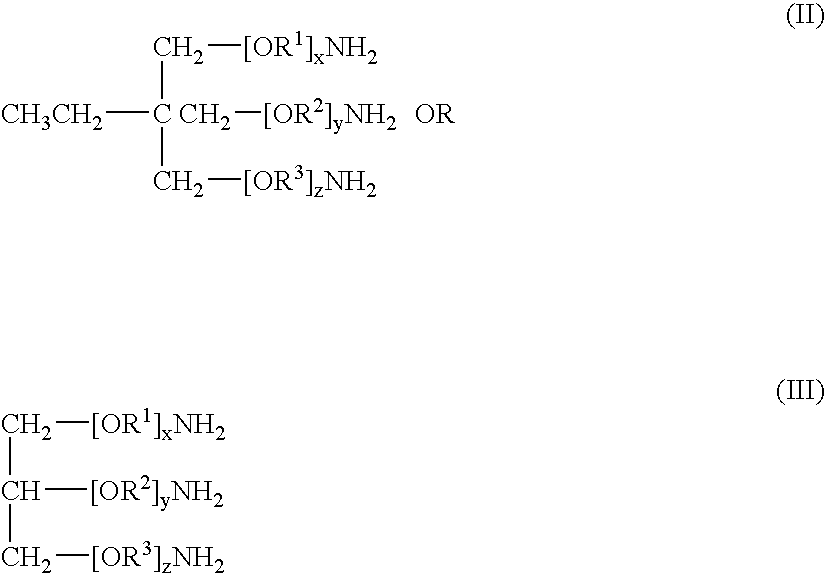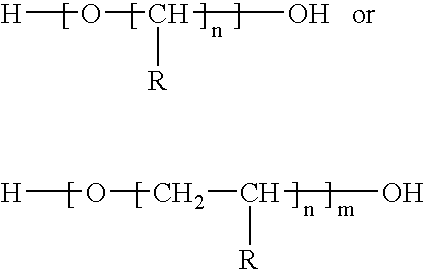Polyether carbamate compounds, compositions containing such compounds, and methods related thereto
a technology of polyether carbamate and compound, which is applied in the field of polyether carbamate compounds, can solve the problems of poor intercoat adhesion between the subsequently applied color coat and the fully cured color coat, and the top coating system, whether monocoat or the aforementioned color-plus-clear system, which is used in automotive applications, and is subject to various defects
- Summary
- Abstract
- Description
- Claims
- Application Information
AI Technical Summary
Problems solved by technology
Method used
Image
Examples
examples
[0125]Example A below describes preparation of the polyether carbamate additive of the invention. Examples B through F describe the preparation of polymers used in the preparation of the tints and base coats. Examples 1 through 8 describe white base coat formulations. Example 1 is a comparative example. Examples 9 through 11 describe black base coat formulations. Example 9 is a comparative example. Examples 12 through 16 describe silver base coat formulations. Example 12 is a comparative example. Examples 13 and 14 describe silver base coats with addition of the polyether carbamate of Example A. Examples 15 and 16 are comparative examples, which are the same as Examples 13 and 14 except for the replacement of the polyether carbamate of Example A with a competitive urethane diol additive.
example a
Preparation of the Polyether Carbamate Additive
[0126]A hydroxy functional polyether carbamate was prepared from the following ingredients:
[0127]
IngredientsAmount (grams)EquivalentsJEFFAMINE D 4001200010Ethylenecarbonate968111Polypropyleneoxide amine from Huntsman Corporation, Texas.
[0128]PROCEDURE: Both the ingredients were added to the reaction vessel and heated to 130° C. The reaction mixture was held at this temperature till greater than 90% of the amine was reacted as measured by potentiometric titration of the mixture, in which the mixture was solubilized in acetic acid and titrated with 0.1 N (normal) perchloric acid in glacial acetic acid. The product was slightly yellowish, had a theoretical % weight solids of 100%, and weight averaged molecular weight of 800 as measured by gel permeation chromatography using polystyrene as internal standard.
example b
Preparation of Acrylic Latex used in Basecoats of Examples 1-16
[0129]Preparation of Isostearic acid polyester. A polyester was prepared in a four-neck round bottom flask equipped with a thermometer, mechanical stirrer, condenser, dry nitrogen sparge, and a heating mantle. The following ingredients were used:
[0130]
ComponentAmount (grams)Isostearic acid1103.0Pentaerythritol800.0Crotonic acid470.0Phthalic anhydride688.0Dibutyltin oxide6.1Triphenyl phosphite6.1Butyl acrylate1170.0NAUGARD ® BHT14.01Butylated hydroxytoluene antioxidant available from Merisol Antioxidants, L.L.C.
[0131]The first six ingredients were stirred in the flask at a temperature of 210° C. until 245 ml of distillate was collected and the acid value dropped to 4.6. The material was cooled to 77° C. and the last two ingredients were stirred in. The final product was a viscous yellow liquid with a hydroxyl value of 54.0, a Gardner-Holdt viscosity of Z+, a weight average molecular weight of 45,600, and a non-volatile c...
PUM
| Property | Measurement | Unit |
|---|---|---|
| temperature | aaaaa | aaaaa |
| pressure | aaaaa | aaaaa |
| temperature | aaaaa | aaaaa |
Abstract
Description
Claims
Application Information
 Login to View More
Login to View More - R&D
- Intellectual Property
- Life Sciences
- Materials
- Tech Scout
- Unparalleled Data Quality
- Higher Quality Content
- 60% Fewer Hallucinations
Browse by: Latest US Patents, China's latest patents, Technical Efficacy Thesaurus, Application Domain, Technology Topic, Popular Technical Reports.
© 2025 PatSnap. All rights reserved.Legal|Privacy policy|Modern Slavery Act Transparency Statement|Sitemap|About US| Contact US: help@patsnap.com



